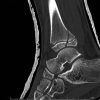Number of cases of DEH are on the rise and more ever in a country like India, where patient education and compliance is poor, it is pertinent to make a correct diagnosis and educate the patient regarding the condition so as to better manage the patient with surgical intervention if need be.
Dr. Spandan Koshire, Department of Orthopedics, Seth Gordhandas Sunderdas Medical College and King Edward Memorial Hospital, Mumbai, Maharashtra, India. E-mail: spndnkoshire11@gmail.com
Introduction: Trevor’s disease also known as Dysplasia Epiphysealis Hemimelica is an uncommon epiphyseal affliction of childhood, developmental in nature with unknown etiology. It is an osteochondral lesion arising from the epiphyses and progressively increasing in size until skeletal maturity is reached. Surgical management is not advisable in cases, where there is absence of articular symptoms and mass evolution is present, until there is achievement of skeletal maturity. Pain, joint deformity, and impingement mandate surgical intervention and the result is good in cases, where the mass is juxta articular or extra-articular in location.
Case Report: We report such a rare case of an 8-year-old male child who presented to us with a hard swelling over ankle with restricted movement and was promptly treated by us with medial malleolus osteotomy and surgical excision of the tumorous mass with subsequent malleolar screw fixation after establishing a diagnosis of osteochondroma of talus.
Conclusion: Making a correct diagnosis with imaging and confirmation by histology is necessary, after which careful surgical planning should be carried out in cases, where bony masses are causing pain, ankle mobility hindrance, and impingement with footwear hampering daily activities, this helps prevent recurrence and its further complications.
Keywords: Dysplasia, Trevor disease, osteochondroma, talus, epiphyses.
Dysplasia epiphysealis hemimelica (DEH) is a rare skeletal developmental disorder of childhood. It affects the epiphyseal region of the bone most commonly affecting the ankle joint followed by the knee. The lesion is a hemimelic osteochondroma with benign features presenting as gradually progressive swelling until skeletal maturity is reached [1]. Fairbank coined the term hemimelica deriving from Greek origin: Hemi meaning half and melos meaning limb in 1956. This disorder was first reviewed by Trevor in 1950 and later in 1956 by Fairbank. The reported incidence being 1 in 1 million people, with <50 cases involving the talus have been reported to date [2]. We report such a rare case involving the talus with its management strategy employed by us to best suit the functional outcome for the patient.
An 8-year-old male child from a poor socioeconomic strata presented for examination 3 months back with swelling and pain on the medial aspect of the left ankle. The swelling was first noticed in infancy but was ignored and has gradually increased in size until the time of presentation. Initially, the swelling was painless, but recently it has become painful and was aggravated by wearing shoes. The use of footwear leads to impingement at the swelling site. This impingement caused skin rubor and dolor due to which the child refused schooling, which prompted the mother to visit our outpatient department for examination of her child. There was no history of trauma or fall given by the mother. During the examination, swelling was noted at the medial aspect of the ankle and measured around 2 × 1.5 cm. Due to inflammation caused by the wear of shoes, there was tenderness at the swelling site. There was limitation of ankle flexion, medial, and lateral rotation though extension, abduction, and adduction were within normal limits. No limb length discrepancy and foot wasting were noted. The patient underwent a radiographic imaging and revealed a bone mass measuring 1.5 × 1 cm with an irregular and thickened structure arising from the talus near the ankle joint and also revealed mild secondary osteoarthritic (OA) changes in the tibio-talar joint (Fig. 1).
Computed tomography (CT) scan described symmetrical bony overgrowth of medial epiphysis of distal tibia with talar bony projections suggestive of DEH of distal epiphysis of tibia and talus with confirmation of secondary OA changes (Fig. 2a, 2b). Magnetic resonance imaging (MRI) scan showed the presence of bony fragments arising from the talar dome and anterior aspect of medial malleolus with no associated periosseous soft tissue and periosteal reaction suggestive of osteochondromas (Fig. 3a-3c). Surgical management was sought on as the child had difficulties in performing tasks of daily living and presented with pain and impingement after donning footwear. A medial approach to ankle was taken and malleolar osteotomy was done to have a better exposure and vision for the tumorous mass which was identified and removed from the talar dome and anterior aspect of medial malleolus. Chemical curettage with phenol was done to complete the procedure of clearance after which medial malleolus fixation with a single cancellous screw was performed (Fig. 4).
Suture removal was uneventful at post-operative day 14 with a healthy suture site (Fig. 5). Histological examination revealed fibrocollagenous tissue containing mature cartilage, bony tissue with marrow in between with an overlying cartilage cap but with absence of atypia suggestive of a benign osteochondroma. A follow-up examination was performed after 3 months post-operative and the child was found to have no pain or impingement with footwear and normal ankle mobility. A written informed consent for publication of this learning article was taken from the child’s mother.
DEH is of unknown etiology, genetic transmission not being a causative factor. Trevor hypothesized deformity on medial and lateral side due to congenital damage to lower limb bud in the early fetal life with affliction of preaxial and postaxial bud, respectively. It is most commonly found in males with a male-to-female of 3:1 and the age of diagnoses being 2–14 and with a rarity in adult population [3]. The literature documentation of DEH remains low with only 250 cases documented worldwide due to the fact that many a times the diagnosis is missed or simply diagnosed as osteochondromas. Based on frequency, most common occurrence of DEH is around knee followed by talus and navicular and first cuneiform bones. In the medical literature, 12% of all cases involve the talus. Around 30 cases worldwide have been reported [4] Most commonly medial epiphyses is affected for growth derailment .Continuous increase in the size of lesion until skeletal maturity is the natural course of DEH. Asymptomatic cases are most commonly encountered in DEH, though there can be features of mechanical symptoms depending on size and location. Reduced motility occurs due to a painless swelling near the joint and can be associated with an articular deformity [5]. Histopathological diagnosis is not pathognomonic in Trevors disease. EXT1 and EXT2 gene expression studies can be done, which are in normal range in DEH and lower in osteochondroma due to a mutation. Being costly in nature limits their utility, and hence, clinical and radiological findings are important for establishing a diagnosis. The diagnosis is confirmed by radiography, CT, and MRI imaging [6]. A mass with focal ossification centers arising from affected epiphysis is seen in the early X-rays, while at later stages, the bony mass gets fused with the epiphysis. CT scan denotes the relation between the mass and the parent bone with articular cartilage and soft-tissue affection. Recently, CT has been replaced with MRI imaging. T2-weighted MRI imaging shows the extent of the mass, state of articular surface, and deformity of the joint. In the final stages of the disease, scintigraphy can be used which shows increased uptake at the site of lesion comparable to the growth plate of epiphysis of interest at a much lower dose of radiation than needed for a skeletal survey [7]. DEH was classified by Azouz et al. as having three particular presentations: localized, classic, and generalized. Histopathological findings of Trevors disease are similar to those in benign osteochondroma, and it is also difficult to discriminate DEH from benign osteochondroma clinically and pathologically. Thus, radiological findings are important in differential diagnosis. Irregular bone growth originating from epiphysis and a distinct ossification focus that can be seen in radiological evaluation are the most important discriminative features of Trevor disease. Apart from osteochondroma, intra-articular loose body, myositis ossificans, or synovial chondromatosis should be included in differential diagnosis [8].
Wait and watch should be the approach in case where there is absence of articular symptoms. Articular impingement or pain warrants surgical treatment. Benign osteochondroma is identified on histological examination and until date malignant transformation has not been recorded in the primary lesion. Articular symptoms are common in such cases due to footwear impingement, thereby leading to alterations in ankle mobility [9]. Although there is a rise in documented cases of DEH being reported, it is still a rare entity. Therefore, whenever examination of a child is being performed for an ankle swelling on the medial or lateral site near the joint, DEH should be the differential diagnosis to be sought after as the diagnosis is simple to make utilizing X-ray and MRI imaging. Observation of the bone mass should be done when there are no symptoms and surgical treatment is essential if impingement features are displayed by the patient and excision is possible if the mass is juxta articular or extra articular. Histological examination confirms the diagnosis of DEH. Early surgical intervention may cause secondary osteoarthritis at the joint when there is presence of intra-articular bony mass and thus in such a scenario is it advisable to defer surgery and only visual examination is recommended as a treatment modality [10].
DEH is a rare disorder of unknown etiology, out of which 12% is comprised of talar osteochondromas. Although histopathological findings in Trevor disease are similar to those in osteochondroma, it has differential features that can be distinguished clinically and radiologically. It is pertinent to make a correct diagnosis with imaging and confirmation by histology after which careful surgical planning is of utmost importance in cases, where bony masses are causing pain, ankle mobility hindrance, and impingement with footwear hampering daily activities, this shall help in preventing recurrence and its further complications.
Although the number of cases of DEH are on the rise, in a country like India, where patient education and compliance are poor, it is important to make a correct diagnosis and educate the patient regarding the condition and the necessary management to be adopted for the welfare of the patient.
References
- 1.Azzoni R. Dysplasia epiphysealis hemimelica of the talus. J Orthop Traumatol 2009;10:43-6. [Google Scholar]
- 2.Kuo RS, Bellemore MC, Monsell FP, Frawley K, Kozlowski K. Dysplasia epiphysealis hemimelica: Clinical features and management. J Pediatr Orthop 1998;18:543-8. [Google Scholar]
- 3.Satija B, Kumar S, Kapoor S, Pawar I. Dysplasia epiphysealis hemimelica of talus mimicking posterior ankle impingement syndrome in a young male: A case report with review of the literature. J Foot Ankle Surg 2013;52:518-22. [Google Scholar]
- 4.Struijs PA, Kerkhoffs GM, Besselaar PP. Treatment of dysplasia epiphysealis hemimelica: A systematic review of published reports and a report of seven patients. J Foot Ankle Surg 2012;51:620-6. [Google Scholar]
- 5.Azouz EM, Slomic AM, Marton D, Rigault P, Finidori G. The variable manifestations of dysplasia epiphysealis hemimelica. Pediatr Radiol 1985;15:44-9. [Google Scholar]
- 6.Ozan F, Doğar F, Gürbüz K, Ekinci Y, Bilal O, Öncel ES. Dysplasia epiphysealis hemimelica (Trevor disease) in the ankle. Ther Clin Risk Manag 2016;12:545-7. [Google Scholar]
- 7.Yurdoglu C, Sahlan S, Oklu T. Hemimelic epiphyseal dysplasia (a case report). Acta Orthop Traumatol Turc 2004;26:348-9. [Google Scholar]
- 8.Bhosale SK, Dholakia DB, Sheth BA, Srivastava SK. Dysplasia epiphysealis hemimelica of the talus: Two case reports. J Orthop Surg (Hong Kong) 2005;13:79-82. [Google Scholar]
- 9.Joshi D, Kumar N, Singh D, Lal Y, Singh AK. Osteochondroma of the talus in a male adolescent. J Am Podiatr Med Assoc 2005;95:494-6. [Google Scholar]
- 10.Gokkus K, Aydin AT, Uyan A, Cengiz M. Dysplasia epiphysealis hemimelica of the ankle joint: A case report. J Orthop Surg (Hong Kong) 2011;19:254-6. [Google Scholar]








